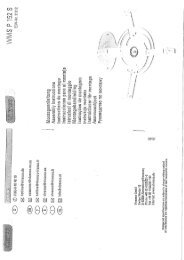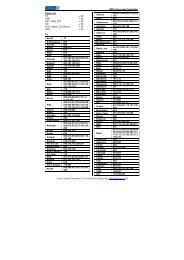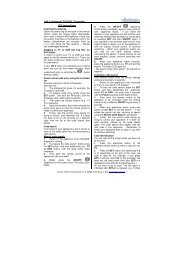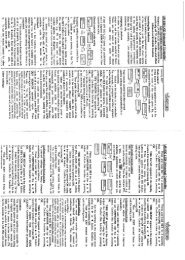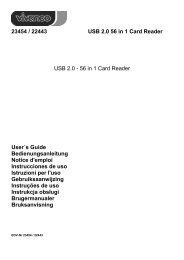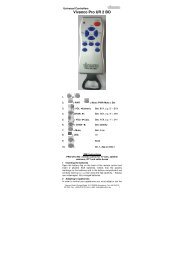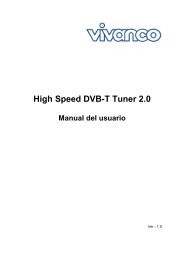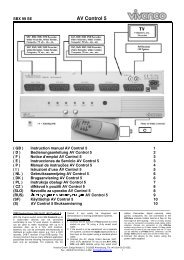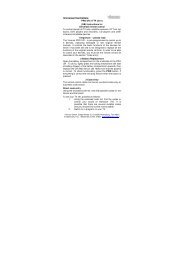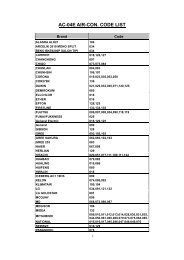computer
computer
computer
- No tags were found...
You also want an ePaper? Increase the reach of your titles
YUMPU automatically turns print PDFs into web optimized ePapers that Google loves.
GLOSSARY“Little SAT lexicon”ADRASTRA Digital Radio. A transmission system that uses ASTRA to transmit twelve stereo radioprogrammes in Hi-Fi quality on a single audio sub-carrier of a TV transponder.AttenuationLoss of signal strength, normally expressed in decibels. Attenuation can occur in the connectioncables between the antenna and receiver. It can also be due to the distance between the transmissionantenna and the receiver antenna.AVShorthand for a button, connection plug or an operating mode to activate or connect audio-visualequipment. The AV connection, e.g. between receiver and TV equipment is normally produced as aScart cable and provides better quality than an antenna cable.AzimuthFrom the position of the observer the skywards direction (east/west) of the satellite.BandBand defines a range of frequencies between two values set according to technical agreement.BandwidthExpression for a series of frequencies, covered by a particular band.BearerVery high-frequency oscillation that due to modulation can carry a radio, or TV signal over greatdistances. The frequency of the oscillation is also the bearer frequency. A TV satellite transmissions,for each television channel there is an image or visual bearer and one or more audio bearers.BowlJargon expression for the parabolic reflector.Broadcasting rangeThe interval between two frequencies that define a band. In satellite receivers it shows the frequencyrange in which you can operate without distortion or error.CATVCommunity Antenna TV. Shorthand for a cable TV signal distribution systemChannelPart of frequency band allocated according to an agreed allocation procedure. A TV channel consistsof two frequencies, one for the visual and one for the audio content. Every channel is identified bynumerical code (except for the European television channels broadcast on the 40-230 MHz frequencyband, which are identified by a letter code).Co-ax cableAn item to provide the electrical connection between antenna and receiver. It consists of a specialcable, which has an inner and an outer core. Each is separated by insulating material, to guaranteeminimum signal loss. Co-ax cable is also called shielded cable because the outer core also protectsthe inner core from outside interference, thereby minimising the signal loss in the inner core.Conditional Access System (CA)To unlock a coded programme, the so-called Conditional Access Module (CAM) is required. Theinterfaces for the CA modules are internationally standard. From this came the Common Interface. Sothat the digital receiver can accept various CAMs, it has one or more interfaces with the Commonnterface Standard. This CI interface provides the necessary to security for the future for later expansionof the digital receiver. There are CA modules not only for play-programmes, but also for otherapplications such as memory cards or modemsControl signal (22 kHz)This means a low-frequency signal around 22 kHz with which the satellite receiver provides anadditional switching capability for the LNB / LNBs. If the signal is switched on or off, it is possible tochoose between several antennas via a box connected between the two.ConverterThe receiver unit at the focal point of the parabolic antenna, to convert from the frequency range ofthe satellite to the intermediate frequency of the receiver.dBDecibel A unit of measurement to express the relationship between values of the same type. It is oftenused to express the attenuation of a cable or distance, or the output of an amplifier.DecoderEquipment to unlock a coded transmission. Each encoding system has an equivalent decoder. Adecoder can also be used to change one format into another (e.g. D2-MAC to PAL).DemodulatorThe circuit in a satellite receiver, the purpose of which is to filter out the audio and video content fromthe bearer signal of a TV channel.DigitalAnd electronic method to process pictures and sounds. It is based on the conversion of picture andsound signals into binary values Digital technology is less prone to interference and the signal qualityis higher. Digital audio is already available on CD, DCC, Minidisc, DAT, ADR, etc. Digital video isavailable on the MPEG system.DiSEqCDigital Satellite Equipment Control – Digital control instructions to reach further stations except for H/Vand 22 kHz.Dolby PrologicA system similar to Dolby Surround. The technique of digital delay is used to achieve much greaterdynamic performance of the main channel, or to assign the voice channel to it, whilst directing specialeffects to the other four speakers.Dolby SurroundA system for the processing of audio information in films, television films and video clips. This systemenables the viewer to be acoustically involved in what is going on. The audio environment is artificiallyreconstructed, so that the classic stereo channels (front right and front left) have three sound sourcesadded: the main channel as well as right rear and left rear channels.Dual FeedThe system for receiving two satellites with a single antenna. The basic requirement for this system is,that the satellites are not more than 9° apart. The system is mainly used for receiving ASTRA 19.2°East und EUTELSAT 13° East.DVBDigital Video Broadcasting. Digital broadcast standard of TV signals in accordance with the MPEGstandard. These techniques are providing impetus to the various European broadcasters, as far as thetransmission of digital TV signals is concerned.ElevationThe term elevation refers to the vertical angle at which the antenna must be positioned to be able tosee” the satellite required. Azimuth, therefore, is the horizontal angle. Elevation the vertical angle -when this is being set the satellite must be “seen”.EPGEPG means Electronic Programme Guide and is an electronic programme magazine that is transmittedwith the programmes. The necessary data can easily be obtained from the data stream transmissionof a programme or bouquet satellite. The EPG data supplied by the programme provider must ofcourse be readable and processable by the DVB receiver. This takes place via the so-calledApplication Programming Interface (API).FMFrequency modulation. A method of modulation whereby the input signal varies the frequency of thecarrier wave.FootprintThe area of the earth's surface covered by the beam from a satellite repeater. It refers to thegeographical area in which the particular TV or radio programme can be received. The footprint canbe represented graphically as a series of more or less concentric circles, each of which has atransmission capacity expressed in dBW. Often, as an alternative the antenna size required within thecircle is shown.FrequencyA unit of measurement for the number of complete oscillations per second, expressed as oscillationsper second, or Hertz (Hz). Therefore, 950 MHz is equivalent to 950 million oscillations per second.GainA unit of measurement, expressed in decibels, to define the amplification capacity of a parabolicantenna or amplifier. Gain is the opposite of attenuation. The gain of an antenna depends on thediameter of the parabolic reflector and its efficiency.Geo-stationaryGeostationary describes objects above the equator that are moving at the same speed as the rotationof the earth. From the position of the observer they appear to be stationaryHDTVHigh Definition Television, or high-resolution television. This system has been tested by broadcastingthe most important sporting events. The main characteristics of HDTV are: wide-screen format (16:09),double the number of screen lines (from currently 625 to 1250) and digital audio quality.LatitudeThe separation expressed in degrees of a particular spot on the surface of the earth and the equator.The corresponding value can be obtained from geographical charts. It is important for the calculationof the elevation and declination when erecting a fixed or moveable antenna.144



